SAILING WITHIN NEW ZEALAND
We didn’t do as much sailing within New Zealand as we would have liked; however, we thoroughly enjoyed the sailing we did. On our way south from Northland to Auckland, we spent 16 days (January 5 – 21, 2006) sailing around the lovely Bay of Islands and a few spots further south. We did not do any sailing during the three months we spent in Auckland. Then, we spent just two days (April 30 – May 1, 2006) sailing north again back to Opua as we were getting ready to head further north for another season in the tropics. Our delightful sailing from Northland to Auckland is described below.
We spent 16 days sailing approximately 100 miles from Opua to Auckland. We spent a week (January 5 – 11) bouncing around the Bay of Islands, then we headed east around Cape Brett. From there our course was mostly southerly. For those unfamiliar with the geography of the north island, we have plotted our course through the Bay of Islands, around Cape Brett, and down as far south as Whangaruru Harbor.

A partial line-up of our powered neighbours
While in Opua Marina, for a short while we had neighbors to starboard (Sue and Michael on SV Tuatara) whom are locals, cruisers, and divers. We struck the mother lode on local information! The day we were leaving the marina, Michael came on board to mark a few favorite spots on our charts.He identified his favorite island – Moturua Island – and his favorite anchorage on that island – Pipi Bay. We were off. We left the marina shortly after noon, and we got to Pipi Bay by 2:30 pm local time. It was really crowded. There were three groups of three large power boats rafted up together and stern tied to shore. There were probably fifteen or more sailboats anchored around the small bay. It was quite crowded, but we decided to drop a hook and see what all the excitement was about. We never did figure that out, but by sundown, there were twenty big powerboats rafted together on the shoreline, and a few more sailboats than earlier. Not exactly the isolation we had hoped for, but we stayed for the night. We were ready to move on in the morning.
There is an annual ‘Tall Ships’ race in the Bay of Islands, and this year’s race was January 7, so we looked for a spot from which we could see the ships if we chose not to go out among them (which, in fact, we did not do). We went back to the North Island and anchored at Onewhero Bay which is in the vicinity of Kerikeri. The most unique thing about the anchorage is that sheep are grazing just off the bow. We still are not accustomed to seeing sheep everywhere we look. We were also pleased that there was only one other boat there the first night, and we were the only boat there through the second night. Unfortunately the race course was a bit far from us to watch much of the race, but the ships are so striking to see that they were quite impressive even from a bit of a distance. The quiet was wonderful.
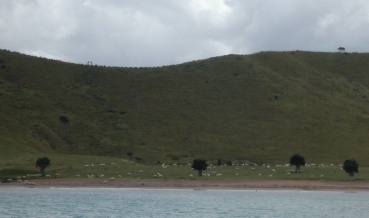
Sheep grazing off our bow
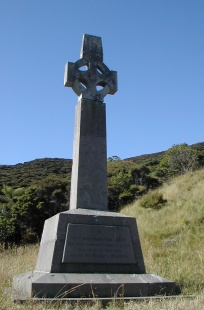
Marsden Cross
Looking for a change of scenery (although we were quite happy with the scenery at Onewhero Bay), we sailed a few miles north through Kent Passage and to Rangihoua Bay – also on the North Island. Rangihoua Bay is the site of the Marsden Cross which is a monument marking the sight of the first Christian service held in New Zealand on Christmas day, 1814, by Samuel Marsden. It is also the site of a Maori pa (fortified Maori village, usually on a hilltop). From the water, it looks like just another coastal hillside, but from on shore, one can still see the terraced hillside and trenches. There were a few boats here, but plenty of room to spread out, so we decided to stay for a few nights. On our second morning here, we noticed a Moorings charter boat near shore with its mainsail up, anchor down, and going nowhere (both wind and sea were extremely calm). We assumed that she was aground and would float off at the next high tide. However, it was so quiet that we could hear their conversation with the Moorings office, and they had a dead battery. They ran their battery down when they anchored by running their windlass without the engine running, and they were calling for help. The Moorings staff was busy trying to get two boats out, and they said it would be four hours before they could get out here to help them. So we hauled up our anchor and went to the rescue. We rafted up alongside and jumped their battery for them. They were very grateful, and we made new friends that we probably otherwise would not have met. A few more ‘good karma’ points in our account…
Our plan was to be in Auckland by January 21, so we thought it wise to start heading in that direction. We only made about five miles on our first effort, and we stopped at Urupukapuka Island. This is the largest island in the Bay of Islands (not counting the North Island, of course), and it has anchorages almost all around it, so there are lots of options. We dropped anchor in the small Otiao Bay (also called Indigo Bay).
During our first afternoon there, we went exploring by dinghy. We scoped out the shoreline around our bay, the next bay south, and around the corner to the bay on the southeast corner of the island. We found very pretty sandy beaches and rugged rocky shores, but we did not find a single mussel for dinner. There were great birds there. Cormorants were in the trees, and orange-billed oyster catchers were poking around the shoreline.
The following morning we went ashore to go hiking. Our first short hike was to a bird blind that was built to view the highly endangered brown teal duck (less than 2,000 of them left). Although we did not see any ducks there, we were very impressed with the habitat and blind that was built there. However, as we walked down the hill to take another trail, we came across three young brown teals playing in a stream. Apparently they didn’t know that they were supposed to be up in their habitat. We hiked up to the top of the island and enjoyed the beautiful 360 degree view. We still haven’t tired of looking at beautiful islands.
We spent one more night, then we forced ourselves to leave the Bay of Islands and start heading south.

Blind for viewing brown teal ducks
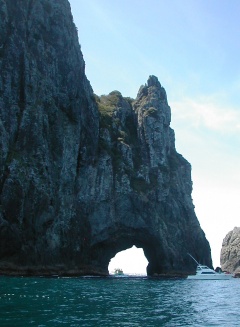
Piercy Island’s ‘Hole in the Rock’
We sailed east to Cape Brett then headed south along the east coast of the north island. Just off Cape Brett is Piercy Island which is better known as ‘Hole in the Rock’. Fast boats from the Bay of Islands bring tourists up there and go through the rock, but it is definitely not for sailboats.
We sailed as far south as Whangaruru Harbor, and we dropped our anchor at Oakura just outside the harbor. However, it was too rolly, so we moved inside the harbor to Puriri Bay. We took the dinghy back to Oakura, and we were charmed by the lovely town and friendly residents. We decided that we wanted to stay for more than one night.
The next day, we again took the dinghy out in search of mussels. Nothing! We had noticed a few boats trawling for scallops, and we saw a diver getting in the water from a boat near us, so when he came up, we went over to ask about the scallops. Although he found a few, they were too few for dinner, so he returned them to the water. And this is how we met our friends Nigel and Janine on SV Soulmate.
When we left Whangaruru Harbor, we had hopes of spending a night or two at Poor Knights Islands. These are uninhabited wildlife preserves, and they are known for their spectacular diving. We knew that there were only a few anchorages, and they were deep, but we went out to the islands hoping we could find something. Although we did not find an acceptable anchorage, we did find the most beautiful islands either of us has ever seen. They are rugged and dramatic, and we spent a few hours sailing around them before heading in to Tutukaka Marina for the night.
Because the Poor Knights Islands are known for their diving, Nita urged Bud to go on a dive charter out there (Nita is not a cold water diver!). Bud hesitated until we again ran into Nigel and Janine (SV Soulmate) whom had already booked a charter for the following morning. They escorted Bud to the dive shop, and he was signed up.
Although the diving was beautiful, the dives were not completely comfortable. Bud wore a 2-piece 7 ml rental wetsuit, and that was just too much gear for a tropical diver. He felt quite constrained, and he spent much of his dive adjusting buoyancy. Nigel and Janine were equally uncomfortable with the rental gear, but a good time was had nonetheless.
A small weather system was blowing over the north island, so we decided to stay a few days in Tutukaka Marina. We stayed three nights, and we were both getting anxious to get to Auckland.
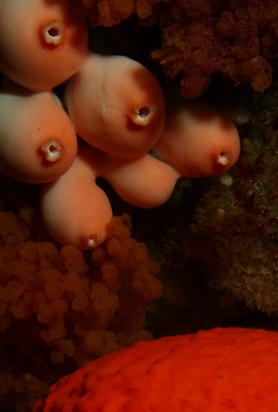
Underwater Colors
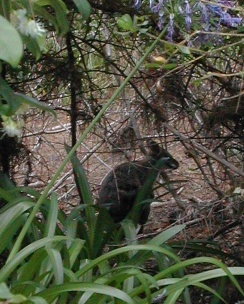
Wallaby
We left Tutukaka Marina and headed for Mansion House Bay on Kawau Island – about 55 miles south of Tutukaka and only about 20 miles outside of Auckland. Although we had to motorsail most of the way, it was still a nice trip. We saw a few more very dramatic islands, and we were happily surprised to see a pod of pilot whales a few hours north of Kawau Island. SV Soulmate had left one day ahead of us, and they were at Mansion House Bay when we arrived, and they had dinner ready for us!
The mansion at Mansion House Bay was the home of New Zealand’s early governor and Prime Minister, Sir George Grey. We toured the house and hiked the island. The house was nice, but the island was great. The island has free-roaming populations of peacocks and wallabies, and there is a spectacular view in any direction one looks. Unfortunately, the wallabies are a bit camera shy, but it was fun to see them hopping about.
Now we are heading off to the bright lights (and big ships!) of the big city. We are off to Auckland where we will be for at least two months – maybe three. This should be an experience!
Follow us to Auckland, return to our New Zealand page, or jump ahead to our sail from New Zealand to Fiji.